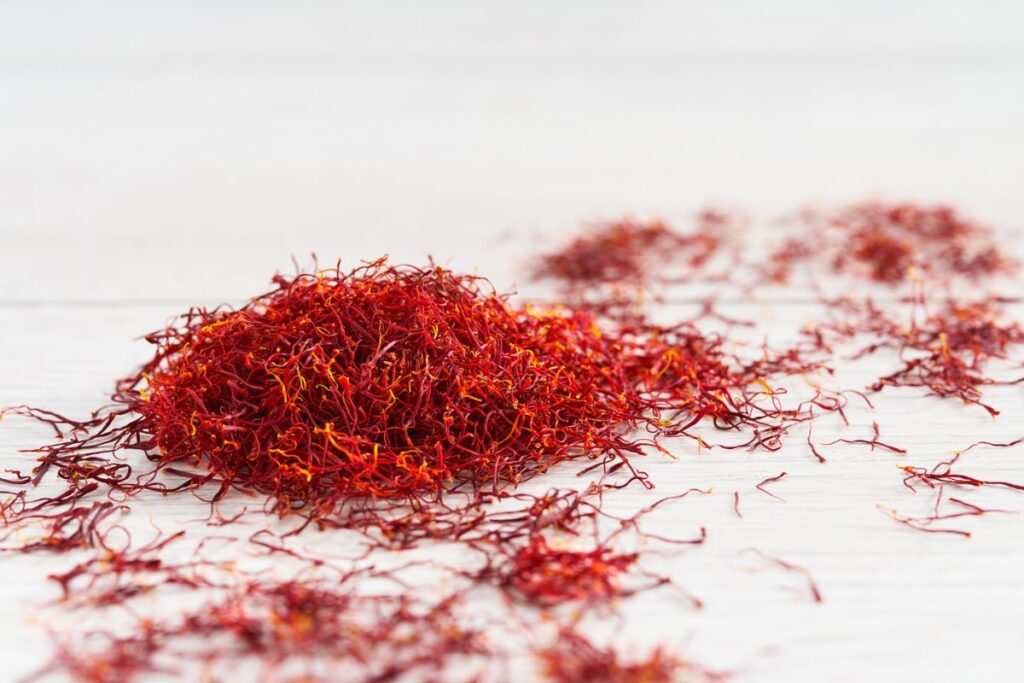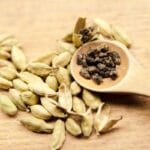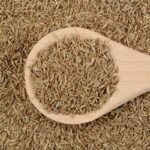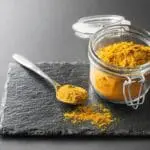Quick summary: Best substitutes for saffron would be turmeric, annatto, cardamom, cumin, and safflower. There’s a replacement solution for almost every dish with saffron you can think of.
If creating million-dollar meals is your thing, you’re probably very familiar with saffron, the most expensive spice in the world. The spice is known for the rich yellow color it imparts to sweet and savory dishes.
This is not the kind of spice that every home cook commonly keeps in the pantry. It’s also not always that easy to find in just any local grocery store.
If your recipe calls for the pricy spice and you need a saffron substitute, we’ve got a list of options that you can easily use instead.
Here are our top substitutes for saffron and how to choose the best saffron replacement for your specific recipe.
Saffron – The Golden Spice
Saffron comes from the crocus sativus plant, cultivated largely in Iran as well as in Spain, Italy, France, and selected parts of India.
Each purple flower yields only three stigmas that are handpicked and dried. It takes 75 000 blossoms to yield one pound (450 grams) of saffron spice. It is thus no surprise that it is the most expensive spice in the world.
Saffron is used in cooking as well as being a dye since it gives off yellow color. The highly fragrant spice has an earthy taste with floral and bitter notes.
It is mainly used in Persian cooking, European and Mediterranean cuisine, as well as Indian cuisine.
Since it is such a unique spice, finding an exact flavor match is not easy when looking for a saffron substitute. Identify the characteristics that are most important to your dish, and then choose the best saffron substitute from our list below.
10 Best Saffron Substitutes
#1. Ground Turmeric
Being from the ginger plant family, fresh turmeric root has a very similar appearance to ginger. The flesh is, however, a bright orange color.
The root is often used fresh but is also found dried and ground in a powder form. It has an earthy, bitter, and slightly spicy taste. It is the best saffron substitute, largely because it also imparts the same yellow color to dishes.
One thing to keep in mind with turmeric is that it does have a pungent flavor and is not the best choice for sweet desserts. Use turmeric sparingly.
Substitute quantity: Use ¼ to ½ teaspoon of turmeric to replace one teaspoon of saffron.
Best for: Savory dishes including curry, paella, soup, rice, couscous, stews, and colored bread.
#2. Annatto
Also known as poor man’s saffron, annatto seeds come from the South American achiote tree. They range from yellow and orange to red, and similar to saffron, they’re used as a natural food coloring agent for sauces, rice, and even paste.
The spice has a slightly sweet, earthy, and peppery flavor and is much more affordable.
Annatto is available in whole seeds, powder, or paste form. When using the seeds, they should either be ground into a powder or steeped in liquid before using.
Add one teaspoon of the seeds to ¼ cup of hot water or milk and let them steep to release the color and flavor. Strain the seeds out and use the liquid extract in your dish.
When using this method, adjust other liquids in your recipe by reducing ¼ cup of liquid elsewhere to prevent changes in the consistency.
Another way to use the seeds is to fry them in neutral oil (canola, safflower, or sunflower oil) and strain the seeds off before using the oil in your dish.
Annatto paste can be used by mixing it with a small amount of water before adding it to your dish. The paste will be stronger than steeping seeds, so only use it in small amounts. If you are using ground annatto, use it as you would any other spice by sprinkling it into your dish.
Substitute quantity: Use ground annatto in equal quantities as a replacement for saffron
Best for: Chicken and pork dishes, spice rubs, marinades, sauces, stews, and coloring baked goods
#3. Cardamom
Cardamom is a popular spice globally. Even though it’s classified as the third most expensive spice, it is more affordable than saffron. It has an aromatic citrusy, spicy, and herbal taste that can be used in sweet and savory dishes.
The spice is popular in Indian, Middle Eastern, and African cuisine and is also known for its use in sweet Scandinavian bread.
The pods have a papery and firm outer covering, and they’re filled with small black cardamom seeds. Although there are different types, green cardamom is the most commonly used type.
Cardamom’s distinct flavor is the strongest when kept in the pod and ground fresh just before using. Buying pre-ground seeds won’t be quite as strong, although they’re still effective.
Cardamom won’t give you the yellow coloring, so if this is a vital part of your dish, you may want to add a touch of turmeric to give you the same color.
Substitute quantity: Use ½ teaspoon of ground cardamom to replace one teaspoon of saffron
Best for: Sweet and savory dishes including pastries, stews, curry, meat rubs, rice, and potato dishes
#4. Ground Cumin
Cumin is not quite as good a substitute in terms of flavor as turmeric or annatto, but it is easily available and something you might even have in the pantry already. It will add a slight color to your dish but is not nearly as rich in terms of color as some of the other substitutes.
Ground cumin has an earthy and more bitter taste, but you can remedy this by adding a pinch of sugar when using it as an alternative.
Substitute quantity: As a replacement for one teaspoon, use only 2/3 teaspoon of ground cumin and a pinch of sugar
Best for: Curry, chutney, rice dishes, stews, bread, soups, and sauces
#5. Safflower (Mexican Saffron)
Safflower plants have a thistle-like structure with yellow flowers. You’re probably more familiar with safflower oil than using the plant in other applications.
It has been used as a saffron substitute for many years and is also used to make natural dye and red paint. Safflower doesn’t have much flavor, so it’s suitable mainly to add to dishes where the color is important, and flavor comes from other spices.
You can pair safflower with other spices that don’t have any coloring properties if you need to add flavor as well as color.
Substitute quantity: Use equal quantities of dried safflower to infuse color
Best for: Dishes where you need to add color without extra flavor, including pasta, risotto, paella, biryani, and sauces
#6. Marigold Flowers
Marigold flowers are part of the sunflower family. You can use a marigold spice or marigold flowers as a successful substitute for added color and flavor.
The spice is not as common and may be difficult to find, but if you have the flowers in your garden, you can easily use the marigold petals to make your own spice.
The petals can be dried in the sun, or a quicker method would be to dry them in the oven at a very low temperature for an hour. You will need to check the petals every 15 minutes and remove the dried ones to prevent them from burning.
Once dry, grind them up into a powder, and you have a perfect substitute for saffron on hand! This is another great option to use in sweet dishes as it lacks the bitter notes of other spices.
Substitute quantity: Use marigold in equal quantities to replace saffron
Best for: Salads, cakes, desserts, tea, rice dishes, and soup
#7. Calendula
Calendulas are flowers that can be used in the same way as marigolds. These yellow flowers have a subtle spicy flavor and longer petals similar to daisies. Dry the petals and grind them up as with the above option to add color and flavor to your dish.
Substitute quantity: Replace calendula in the same quantity called for in your recipe
Best for: Rice dishes, soups, baked goods, paella, and salads
#8. Sweet Paprika
Sweet paprika is an easy-to-find substitute and another spice you likely have in the pantry already.
Note that it is not the same as other types of paprika, such as smoked paprika or hot paprika. Hot paprika especially has a much spicier peppery taste. Those won’t work as a substitute, so make sure it’s sweet paprika specifically.
The spice is made from dried and ground red bell peppers and is very affordable. It has a slightly sweet flavor with spicy undertones. However, the color is more on the red side than yellow. This means your dishes will have a darker color.
Substitute quantity: Use ½ teaspoon of sweet paprika to replace one teaspoon of saffron
Best for: Any savory recipe that requires a substitute
#9. Curry Powder
Curry powder is a mix of spices, generally including cumin, coriander, chili spice, and turmeric, in addition to others, depending on the variety of curry.
Since it contains turmeric, you will get a similar color; however, some curry powders are more orange or red. Essentially the type of curry powder you have will influence how dark your dish turns out and how spicy it is.
One important thing to keep in mind when using curry powder as a substitute is that it has a much stronger flavor profile. If you add too much, you can instantly change the entire flavor profile of your dish, so use it sparingly and add a little at a time if needed.
Substitute quantity: Start with half of what the recipe requires and then add more to taste if needed.
Best for: Curries, soups, sauces, rice dishes, and vegetable dishes
#10. Food Coloring
Food coloring is not our top choice as a saffron substitute, but if all else fails and you really need that yellow color in your dish, you can use it as a last resort. Food coloring won’t add any flavor, so it is suitable to add to dough that you have already spiced but that lacks the color.
Artificial colorings are very bright, so use one or two drops only to keep it authentic. Adding just one drop too many may have you serving up a luminous yellow dinner or dessert.
FAQ
When buying real saffron, choosing threads is advised over buying ground saffron. Powders are easily mixed with other ingredients and sold at prices just as high as the pure ingredient.
Also, look for threads that don’t have the yellow style still attached. The style does not bring any color or flavor and is thus just dead weight adding to the price of the spice.
Use three saffron threads per person you are cooking for (or per serving). You really don’t need much. Adding too much will make the dish taste bitter.
The spice is popular in rice dishes, paella, fish, risotto, Indian biryani, bouillabaisse, flan, Indian sweet treats, and Persian puddings.
The filaments are very sensitive to light and oxygen, so they need to be kept in a dark, airtight
environment to maintain their quality.
Store the spice below 68 °F (20 °C) in an airtight metal or glass container. Plastic will decrease the quality, so it’s best to avoid keeping it in a plastic container. If the container you are using is transparent, wrap the filaments in foil to protect them from exposure to light.
Saffron is a sought-after spice and adds a unique flavor and color to many dishes. Although it is hard to replicate the same taste, there are a number of alternatives you can use to get a similar result.
For the same signature yellow color, we recommend using turmeric or annatto as your go-to options. These two spices will also add an earthy flavor, each with unique properties.
If your main concern is getting flavor without the color, cardamom can be used in both sweet and savory dishes, which makes it a good option.
Whichever spice you choose to use, start off with the amounts recommended in this guide and gradually add more if needed. Adding too much initially can irreversibly change the profile of your dish. As always, keep tasting along the way.
Happy cooking and happy feasting!
You should also check this interesting info about vanilla.
*image itor115.gmail.com/depositphotos









